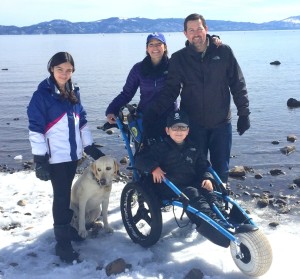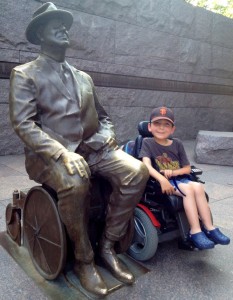
[Steve Ragland, his wife, and two children are all on a snowy rocky shore in winter garb, with water and mountains behind them. His daughter stands by their yellow labrador and his son sits in a wheelchair built for rugged terrain.]
Why were you interested in joining DRA’s Advisory Board?
My 9 year old son Logan has a neuromuscular condition called spinal muscular atrophy (SMA), which affects the motor nerve cells in the spinal cord and leads to severe muscle weakness. He is a wheelchair user who got his first powerchair at about 2-1/2 years old. Disability rights are near and dear to my heart because I navigate the world not just looking for curb cutouts, but also thinking about my son’s future and the opportunities he’ll have. Part of the reason I went to law school is to acquire the tools to make people do the right thing when they refuse to do so and injure someone or discriminate against a group of people. I want to use my skills to help ensure dignity and justice for everyone. I have been involved in a community of parents of children with SMA and adults living with SMA for many years, but that does not involve legal work. I wanted to extend my efforts to both reach a broader community and to put my legal training to work.
Why do you think DRA’s work is urgent and important?
I believe the keys to a just society are access, opportunity, dignity, and respect; and it is high time that persons with disabilities are a full part of the civil rights dialog and not just an afterthought—or ignored altogether. On a personal level, I want to be able to take my family to New York City and not worry about how to hail an accessible cab or getting caught at a subway station without an elevator. And my family has been lucky. Many people with disabilities are routinely denied access to education, work, healthcare, or other crucial things, and don’t have the means or ability to speak up and fight yet another battle. Unfortunately, for people with disabilities, prejudice and barriers are still acceptable in ways they are not for other groups who have struggled for civil rights. Prejudices that were rampant when I was a kid don’t even occur to my children, but there is still work to do. DRA’s work and victories bring awareness, dignity, and an important social shift in the perception of people with disabilities for our society as a whole.
What do you hope for DRA’s future and society’s future?
I hope that DRA continues to pioneer new frontiers: that as society expands and our view of equality expands, DRA’s cases will keep pushing the envelope. DRA can lead the disability rights movement and society will follow. I believe that things like universal design will be second nature at some point, and the key is to make that point sooner rather than later.
Any other fun anecdotes or stories you want to share?

In my office, I have a picture that I took at the FDR memorial of my son next to President Roosevelt in his wheelchair, and a small statute of Professor X (of X-Men fame) sitting authoritatively in his powerchair. Those images are so important to me and I want my son to have more leaders and role models who he can look up to and aspire to emulate.